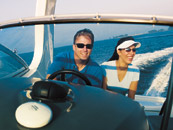Computers are all around us in our everyday lives; you’re reading this on a computer screen—and this document was created on a computer.
If the engine on your boat is less than about five years old, chances are that its functions are monitored and controlled by a small, yet powerful, computer. An engine’s computer isn’t very big—but this mini-module keeps track of atmospheric pressure/air density, ambient temperature, and engine load (among other things), and sends the precise amount of fuel, at just the right time, to the engine. The result is better fuel economy and reliability than thought possible less than ten years ago.
In recent years, engine and boat manufacturers have begun networking engine computers throughout the boat. Now, digital instruments can tell you the engine’s fuel consumption and how far you can go with the remaining fuel supply, how much fresh water you have on board, or if it’s time to empty the waste water holding tank.
Electronic navigation devices are some of the more high-profile examples of computers put to good use on your boat. A satellite navigation system (sat nav) or global positioning system (GPS) can provide nearly instant feedback to let you know where you are, and when coupled to an autopilot, they can get you to where you want to be.
As technology and topography changes, you can easily update your electronics navigation software with the latest upgrades, maps, and charts.
On some larger boats with really high-tech electronics, you can download information from the internet (or a CD) onto your laptop computer at home, and then plug the laptop into your boat’s navigational system. You’ve got to keep the laptop out of the elements, though; most computer screens are hard to see in the sunlight and just a splash of water will render your laptop useless.
